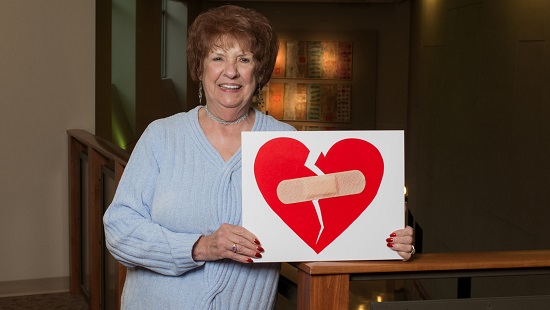Heart Care
An Easier Way to Fix Faulty Heart Valves

At UM St. Joseph Medical Center, Specialty Heart Surgeons Perform a Minimally Invasive Surgery Known as Transcatheter Aortic Valve Replacement (TAVR) to Treat One of the Deadliest Diseases — Hardening of the Heart Valves.
Evelyn Kimball was diagnosed with aortic stenosis—a narrowing of the heart valve caused by calcium buildup—and told that she needed valve replacement. The first thing Kimball said to her cardiologist, Stephen Pollock, MD, was, "I don't want my chest opened!" It was her understanding that heart valve replacement required open-heart surgery. Kimball's husband had quadruple bypass open-heart surgery at UM St. Joseph Medical Center (UM SJMC) 10 years before, and she had been his main caregiver. Although her husband's recovery had been outstanding, Kimball knew it was a major operation.
An Alternative to Open-heart Surgery
As serious as Kimball's diagnosis was — without treatment, 50 percent of symptomatic patients die within two years — Dr. Pollock, a board-certified cardiologist, told her that the silver lining was that cardiac care at the University of Maryland Medical Center was on the cutting edge of a revolution in valve replacement that did not require opening the chest.
Patients of Kimball's age, who are frail or with pre-existing medical conditions, could qualify for a minimally invasive procedure called TAVR, which stands for transcatheter aortic valve replacement. At the time, only a handful of cardiac hospitals around the country offered this innovative treatment.
Heart Specialists with Incredible Experience
TAVR is similar to having a cardiac stent. A catheter is inserted through the patient's groin and guided up to the heart, explains UM SJMC board-certified cardiac surgeon Rawn Salenger, MD, clinical assistant professor of surgery at the University of Maryland School of Medicine. "At the tip of the catheter is a stent frame containing a new valve that is deployed into the space of the old valve, pushing it aside and opening up in its place," says Dr. Salenger, who is half of the dynamic doctor duo on the TAVR heart team. The other half is Shumile Zaidi, MD, MBBS, director of the Structural Heart Disease Program at UM SJMC and clinical assistant professor of medicine at the University of Maryland School of Medicine. Dr. Zaidi is board-certified in internal medicine, cardiology, interventional cardiology, echocardiography and nuclear cardiology.
Originally, TAVR only was available for patients who were inoperable or at high risk for open-heart surgery. ";As of 2016 thanks to clinical studies, the FDA [Food & Drug Administration] and CMS [Center for Medicare Services] decided that patients at intermediate risk, as determined by their cardiac surgeon and interventional cardiologist, are also eligible for TAVR," Dr. Zaidi says. "Now, almost 50 percent of aortic valve replacement performed in the U.S. is done using TAVR. The main reasons that TAVR is considered superior are that it provides a faster recovery and avoids the risk factors of undergoing major open-heart surgery.
Quick Recovery Faster Results
"TAVR surgery is shorter, less traumatic and creates less anxiety for the patient,"; Dr. Salenger adds. "Patients stay in the hospital a couple of nights. They experience the benefits of TAVR right away without giving up two months for recovery from open-heart surgery."
"CMS is making sure that only cardiac surgery hospitals can perform TAVR, and that the cardiac team is highly experienced, performing a large volume of cardiac surgeries every year," says Dr. Zaidi.
In order to bring the greater Baltimore community the latest, minimally invasive treatment for valve replacement, UM SJMC opened a hybrid TAVR operating room, bringing the same state-of-the-art TAVR surgery that's also available at the University of Maryland Medical Center.
A Heart Team and Operating Room Like No Other
The hybrid TAVR operating room has a Star Trek-like quality. "It has everything that a cardiac operating room has along with an advanced state- of-the-art cardiac catheterization laboratory," Dr. Salenger says. "There are multiple screens that provide us with images that allow us to operate from every angle. We have the ability to look at the CT scan, the echocardiogram, angiography and hemodynamics at the same time. This awareness increases our ability to pick the precise position to open the new heart valve into the space of the old, diseased one."
Nine medical personnel work in the OR during a TAVR procedure. "he hybrid OR brings the concept of the heart team to the forefront. TAVR has transformed heart medicine. We have a cardiac surgeon, interventional cardiologist, cardiac anesthesiologist, echocardiographer, perfusionist and more in the room," says Dr. Salenger. "We work as a unit. It's very exciting. Plus, this OR is one of the best in the world."
The TAVR heart team was not only excited about the new OR, but also about the ability to save more lives. "Aortic stenosis can be more deadly than some types of metastatic cancer," explains Dr. Zaidi.
Seek Lifesaving Medical Help Immediately
The biggest risk factor for developing aortic stenosis is aging. Most patients are in their 70s and 80s. "By the age of 85, about 40 percent of people have aortic stenosis. When the aortic valve gets narrow from calcification, the body does not get enough oxygen to the brain, lungs and heart," says Dr. Zaidi. "Before TAVR was available, many patients with aortic stenosis were inoperable and died within two years. There was nothing we could do. There is no medication that can help," he adds.
Evelyn Kimball had no pain or discomfort from TAVR. "I gave the doctors a thumbs-up when I awoke after TAVR. A couple days later, I was cooking and baking. I felt great. Dr. Zaidi and Dr. Salenger are miracle workers."
"By replacing a diseased valve, we can change the quantity and quality of a person's life so that they can live longer and better," Dr. Zaidi says.
